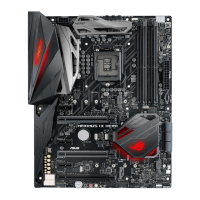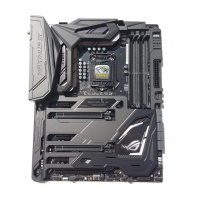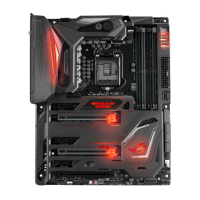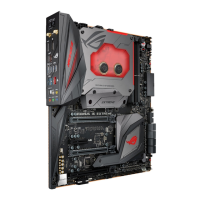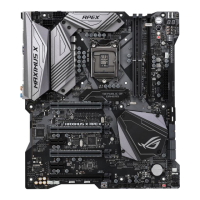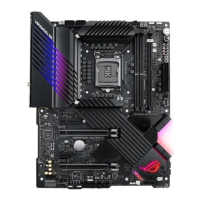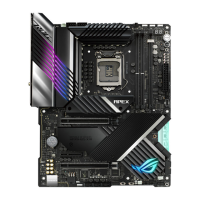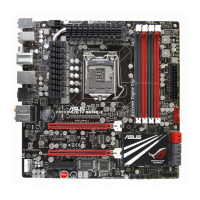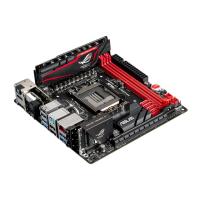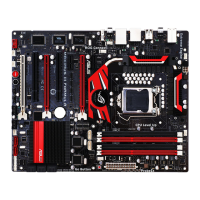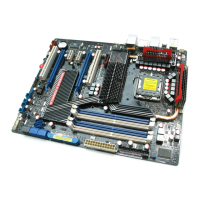Do you have a question about the Asus MAXIMUS IX APEX and is the answer not in the manual?
Precautions to prevent electrical shock hazards during system operation and maintenance.
Guidelines for safe handling and operation of the motherboard and its components.
Details about the CPU socket, supported processors, and Turbo Boost technology.
Specifications for DDR4 memory, including capacity, speed, and architecture.
Details on storage interfaces like SATA, M.2, and RAID support.
List of physical connectors on the rear I/O panel.
Lists the types and quantities of cables provided in the package.
Lists various accessories included with the motherboard.
Lists necessary tools like screwdrivers, chassis, PSU, CPU, fan, RAM, and storage.
Provides an overview of the motherboard and its features.
Lists precautions to take before installing components or changing settings.
Illustrates the physical layout of the motherboard and its connectors.
Details the CPU socket type and compatibility with Intel processors.
Describes the motherboard's DDR4 DIMM slots and memory configuration.
Details the PCIe slot configurations and their operating modes.
Explains the function of onboard buttons like Power-on, Reset, and MemOK!.
Describes Safe Boot and Slow Mode switches for system stability and overclocking.
Explains PCIe x16 Lane and BIOS Switch buttons for configuration.
Details ReTry and Pause switches for overclocking and system control.
Introduces onboard LEDs for system status, including Q LED.
Explains Condensation detection and Q-Code LEDs for system status and error codes.
Provides a table of Q-Code error codes and their descriptions for troubleshooting.
Introduces motherboard jumpers, including LN2 and DRAM channel jumpers.
Introduces internal motherboard connectors, focusing on SATA.
Details USB 3.0 and thermal sensor connectors for connectivity and monitoring.
Explains various fan and pump connectors for cooling system management.
Details ATX power connectors and PSU recommendations for system stability.
Explains front panel connectors for power, LEDs, and buttons.
Details the DIMM.2 slot for connecting M.2 SSD modules.
Introduces ProbeIt for detecting system voltage and OC settings.
Provides guidance on building a PC system.
Steps for installing the motherboard into the PC chassis.
Detailed steps for installing the CPU into the LGA1151 socket.
Steps for installing the CPU heatsink and fan assembly.
Step-by-step guide for installing DDR4 DIMM modules.
Guides on connecting ATX power and SATA devices.
Steps for installing PCIe x16 and PCIe x1 expansion cards.
Introduces BIOS update utilities, focusing on USB BIOS Flashback.
Overview of rear I/O connections and their functions.
Details the rear panel connectors and their functions.
Illustrates audio connections for headphones, microphones, and speakers.
Guide on initial system startup procedures and POST checks with BIOS Beep codes.
Introduces the ASUS UEFI BIOS and its basic functions.
Explains how to enter and navigate the BIOS setup program.
Explains how to enter BIOS setup during and after POST.
Overview of the EZ Mode screen for basic system information and settings.
Introduction to Advanced Mode for experienced users and configuration options.
Explains menu bar, items, submenus, language, and hotkeys.
Details the Q-Fan Control feature for managing fan speeds.
Guides on setting fan profiles and manually configuring fan speeds.
Explains EZ Tuning Wizard for overclocking, usage, and RAID setup.
Steps to start OC Tuning using the EZ Tuning Wizard.
Instructions on creating a RAID set using the EZ Tuning Wizard.
Describes My Favorites as a personal space for saving and accessing BIOS items.
Overview of Main menu for system info and Security menu for settings.
Menu for configuring overclocking-related items.
Details Ai Overclock Tuner, BCLK, TPU, Core Ratio, and DRAM Frequency settings.
Introduction to the Advanced menu for CPU and system device settings.
Shows CPU-related information detected by the BIOS.
Configures PCH Storage, SATA modes, and PCIe speeds.
Configures ROG Effects, Onboard LEDs, and Q-Code LED functions.
Configures onboard devices like HD Audio, M.2, USB Type-C, RGB LED, and LAN.
Settings for power management, network, storage SMART, and USB features.
Displays system status and allows fan control via Q-Fan.
Options for system boot behavior, including Fast Boot and Setup Mode.
Configures Compatibility Support Module and Secure Boot settings.
Accesses special functions like Setup Animator and ASUS EZ Flash 3.
Cleans SSDs to restore factory performance levels.
Manages overclocking profiles and configures ROG OC Panel H-Key.
Options to load defaults, save changes, or discard changes and exit BIOS.
Provides information and warnings about updating the motherboard BIOS.
Utility to update motherboard BIOS in Windows environment.
Utility to update BIOS via USB flash drive or Internet.
Auto recovery tool to restore BIOS when it fails or gets corrupted.
Overview of motherboard support for Intel Rapid Storage Technology RAID.
Explains RAID 0, RAID 1, RAID 5, and RAID 10 data configurations.
Steps to enter and configure Intel RST in UEFI BIOS.
Steps to create a RAID volume using the Intel Rapid Storage Technology menu.
Warning about data loss when deleting a RAID set.
Instructions to enter the Intel RST Option ROM utility.
Guides on creating a RAID driver disk for Windows OS installation.
Steps to load the RAID driver during OS installation.
Regulatory notices, including FCC statement.
FCC compliance statement regarding device operation and interference.
Compliance statements for Canada (IC) and Japan (VCCI).
Information on REACH regulations and California chemical warning.
Contact details for ASUSTeK Computer Inc. headquarters.
Contact details for ASUS Computer International in America.
Contact details for ASUS Computer GmbH in Germany and Austria.
FCC Declaration of Conformity statement confirming compliance with regulations.
| Form Factor | ATX |
|---|---|
| Socket | LGA 1151 |
| Chipset | Intel Z270 |
| Memory Slots | 4 |
| Max Memory Support | 64 GB |
| Memory Type | DDR4 |
| PCIe 3.0 x16 Slots | 2 |
| PCIe x16 Slots | 2 |
| PCIe 3.0 x4 Slots | 1 |
| PCIe x1 Slots | 1 |
| SATA 6Gb/s Ports | 6 |
| M.2 Slots | 2 |
| USB 3.1 Gen 2 Type-A | 2 |
| USB 3.1 Gen 2 Type-C | 1 |
| USB 3.1 Gen 2 Ports | 2 |
| USB 3.1 Gen 1 Ports | 6 |
| USB 2.0 Ports | 6 |
| USB Ports | 14 |
| Audio | SupremeFX |
| LAN | Intel I219-V |
| RAID Support | 0, 1, 5, 10 |
| Multi-GPU Support | NVIDIA 2-Way SLI, AMD 3-Way CrossFireX |
